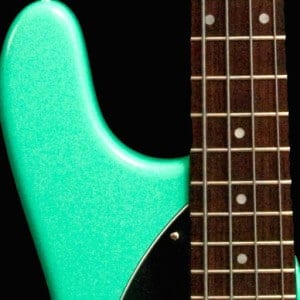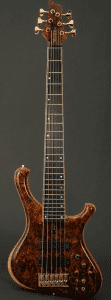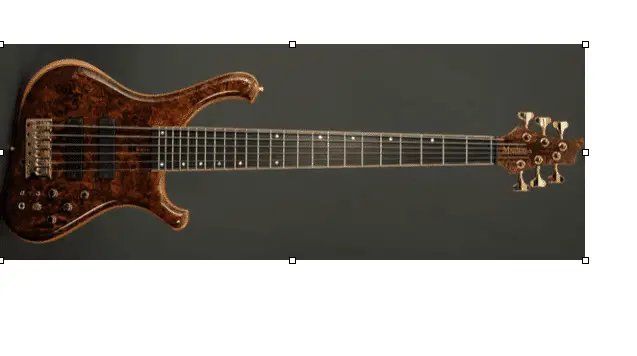Here is a question I got in from Rob:
“I am presently finishing up your course from Truefire – Pentatonic Playground which has really helped me and I love it. My question is I recently came across a very nice Ibanez BTB sixstring which I hope to be able to eventually play and wonder on the difficulty of moving from a four- to sixstring directly – not taking a intermediate step to fivestring – what would you recommend – Thanks for any help and direction.”
Good question, Rob. My personal path was from the four to the five, then the sixstring and it happened over a long period of time. I would say the transitions happened fairly organically for me, adding the B came naturally. When I added the sixstring to my arsenal I found myself playing very different styles and techniques (tapping, chording etc.).
I was curious how others made the transition, so I passed the question on to one of our guest contributors, bassist, composer and educator Wolf Wein. Find out more about Wolf on the Contributors Page.
Enjoy!
Moving from Fourstring to Sixstring
by Wolf Wein
 I started out on fourstring. I learned the scales, arpeggios, intervals and where everything is on the fourstring first. Some of the tunes I played required to detune the E string down to D and even C, so finally I gave in and went to the five. Fivestringers are still my main axes today. I love the extra low notes – bass bass is so much fun. Yet, the fourstring still forms my main internal reference for fretboard knowledge – and I’m not fighting that at all when I switch to five- or sixstring. But what does it take to switch – back and forth? How does one adapt? Great question!
I started out on fourstring. I learned the scales, arpeggios, intervals and where everything is on the fourstring first. Some of the tunes I played required to detune the E string down to D and even C, so finally I gave in and went to the five. Fivestringers are still my main axes today. I love the extra low notes – bass bass is so much fun. Yet, the fourstring still forms my main internal reference for fretboard knowledge – and I’m not fighting that at all when I switch to five- or sixstring. But what does it take to switch – back and forth? How does one adapt? Great question!
Lets use the major scale as an example: the various shapes of creating a major scale are my starting point here, as I know them very well. When extending them for five and sixstring, I would start with the fourstring pattern and then extend that down and/or up until eventually (after some serious deliberate practice) I’ll have the “extended shapes” in my mind and under my fingers.
However, the four-string bass remains the core of my playing even when on the sixstring: I use the low B string mostly for the five notes below the low E. Occasionally I will use a note of the B string higher up the neck if the fingering works out better. I use the high C string in chords, for soloing and to extend the range in a given position without having to jump up the neck – the five extra high notes at the end of the fretboard are not that crucial to me. I hardly ever use the C string for groove playing – it just sounds too much like a guitar and not fat enough to me.
On the fivestring the added low B threw me kinesthetically at first – my hands were not used to the lowest string no longer being the E. So the biggest challenge for me were not the few extra notes or where notes are on the new strings. Like I wrote, that’s easy to figure out by simply extending already existing fretboard knowledge. The biggest challenge was muscle memory and how a five (or six) string feels differently than a four-string. I am pointing this out because this informed what I needed to work on most in order to adapt – kinesthetics, or getting used to the slightly different layout and the new distances.
When slipping into established habits I would sometimes find myself playing a fourth too low. This WILL earn you stern looks from all band members. The remedy was to constantly remind myself of the “new” string being there, This of course meant letting go of the autopilot (“muscle-memory mode”) that I had trained so hard for.
If you find yourself in that situation – don’t make it a fight; it just takes a little bit of extra awareness and very soon your mind and body will adapt to the new terrain. And I’m happy to say, that I find switching back to the four-string easy, no challenge at all.
How to practice the transition to the sixstring
 Focus on just the outer strings as you combine them with the adjacent strings, meaning: play a scale using only low B and E strings – play scales only on these two strings. Do the same for the G and high C strings. also play horizontal scales using only the low B or high C strings – great for familiarizing ourself with the note names and locations on these new strings.
Focus on just the outer strings as you combine them with the adjacent strings, meaning: play a scale using only low B and E strings – play scales only on these two strings. Do the same for the G and high C strings. also play horizontal scales using only the low B or high C strings – great for familiarizing ourself with the note names and locations on these new strings.
Practice familiar bass lines, scales … and say the note names while you play. This will speed up becoming familiar with the new note locations. I also highly recommend practicing reading sheet music and making sure to incorporate the new/different strings.
To train your right hand, play open string exercises like B-E-B-A-B-D-B-G; The idea here is easy: use the B string as a pedal note. Also, use other strings as the pedal note. play B-E-A-D-G-D-A-E-B; or groups of three strings – in short: any and all of typical open string exercises where you focus on the right hand. Pay extra attention to how it feels. Heightened awareness makes for faster learning. Once this feels a little familiar, play arpeggios (preferably triads, but you can start with seventh chords as they are easier on the right hand) incorporating all five (or six) strings.
Many more exercises are possible and useful. I hope the above material gives you some ideas to get started on your extended strings journey.
In Summary
Whichever bass version you start on, do your best to learn the fretboard in and out – in every key and every position. This will become your primary reference. When you switch to a different string number, you don’t have to unlearn what you know, you use it as a starting point and add to (subtract from) it.
Photos: Basses by Marleaux Bass Guitars Germany.



